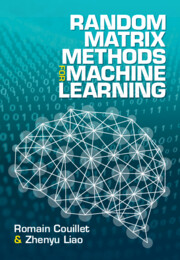Refine listing
Actions for selected content:
9096 results in Communications, Signal Processing and Information Theory
1 - Introduction
-
- Book:
- Random Matrix Methods for Machine Learning
- Published online:
- 30 June 2022
- Print publication:
- 21 July 2022, pp 1-34
-
- Chapter
- Export citation
Contents
-
- Book:
- Random Matrix Methods for Machine Learning
- Published online:
- 30 June 2022
- Print publication:
- 21 July 2022, pp v-vi
-
- Chapter
- Export citation
8 - Universality and Real Data
-
- Book:
- Random Matrix Methods for Machine Learning
- Published online:
- 30 June 2022
- Print publication:
- 21 July 2022, pp 364-377
-
- Chapter
- Export citation

Random Matrix Methods for Machine Learning
-
- Published online:
- 30 June 2022
- Print publication:
- 21 July 2022
Index of Special Symbols
-
- Book:
- Compound Renewal Processes
- Published online:
- 16 June 2022
- Print publication:
- 30 June 2022, pp 363-364
-
- Chapter
- Export citation
10 - Uplink Performance Analysis of Ultra-Dense Networks
- from Part IV - Dynamic Time Division Duplexing
-
- Book:
- Fundamentals of Ultra-Dense Wireless Networks
- Published online:
- 17 June 2022
- Print publication:
- 30 June 2022, pp 329-349
-
- Chapter
- Export citation
Frontmatter
-
- Book:
- Compound Renewal Processes
- Published online:
- 16 June 2022
- Print publication:
- 30 June 2022, pp i-iv
-
- Chapter
- Export citation
Frontmatter
-
- Book:
- Fundamentals of Ultra-Dense Wireless Networks
- Published online:
- 17 June 2022
- Print publication:
- 30 June 2022, pp vi-vi
-
- Chapter
- Export citation
Part I - Getting Started
-
- Book:
- Fundamentals of Ultra-Dense Wireless Networks
- Published online:
- 17 June 2022
- Print publication:
- 30 June 2022, pp 1-2
-
- Chapter
- Export citation
Part III - Capacity Scaling Law
-
- Book:
- Fundamentals of Ultra-Dense Wireless Networks
- Published online:
- 17 June 2022
- Print publication:
- 30 June 2022, pp 279-280
-
- Chapter
- Export citation
Foreword
-
- Book:
- Fundamentals of Ultra-Dense Wireless Networks
- Published online:
- 17 June 2022
- Print publication:
- 30 June 2022, pp xvii-xviii
-
- Chapter
- Export citation
9 - System-Level Network Optimization
- from Part III - Capacity Scaling Law
-
- Book:
- Fundamentals of Ultra-Dense Wireless Networks
- Published online:
- 17 June 2022
- Print publication:
- 30 June 2022, pp 311-326
-
- Chapter
- Export citation
Preface
-
- Book:
- Fundamentals of Ultra-Dense Wireless Networks
- Published online:
- 17 June 2022
- Print publication:
- 30 June 2022, pp xix-xx
-
- Chapter
- Export citation
Dedication
-
- Book:
- Fundamentals of Ultra-Dense Wireless Networks
- Published online:
- 17 June 2022
- Print publication:
- 30 June 2022, pp v-v
-
- Chapter
- Export citation
11 - Dynamic Time Division Duplexing Ultra-Dense Wireless Communication Networks
- from Part IV - Dynamic Time Division Duplexing
-
- Book:
- Fundamentals of Ultra-Dense Wireless Networks
- Published online:
- 17 June 2022
- Print publication:
- 30 June 2022, pp 350-380
-
- Chapter
- Export citation
2 - Integro-Local Limit Theorems in the Normal Deviation Zone
-
- Book:
- Compound Renewal Processes
- Published online:
- 16 June 2022
- Print publication:
- 30 June 2022, pp 57-89
-
- Chapter
- Export citation
3 - Performance Analysis of Traditional Sparse and Dense Wireless Networks
- from Part I - Getting Started
-
- Book:
- Fundamentals of Ultra-Dense Wireless Networks
- Published online:
- 17 June 2022
- Print publication:
- 30 June 2022, pp 73-100
-
- Chapter
- Export citation
5 - Integro-Local Limit Theorems under the Cramér Moment Condition
-
- Book:
- Compound Renewal Processes
- Published online:
- 16 June 2022
- Print publication:
- 30 June 2022, pp 225-274
-
- Chapter
- Export citation
1 - Introduction
- from Part I - Getting Started
-
- Book:
- Fundamentals of Ultra-Dense Wireless Networks
- Published online:
- 17 June 2022
- Print publication:
- 30 June 2022, pp 3-28
-
- Chapter
- Export citation
Foreword
-
- Book:
- Fundamentals of Ultra-Dense Wireless Networks
- Published online:
- 17 June 2022
- Print publication:
- 30 June 2022, pp xv-xvi
-
- Chapter
- Export citation
